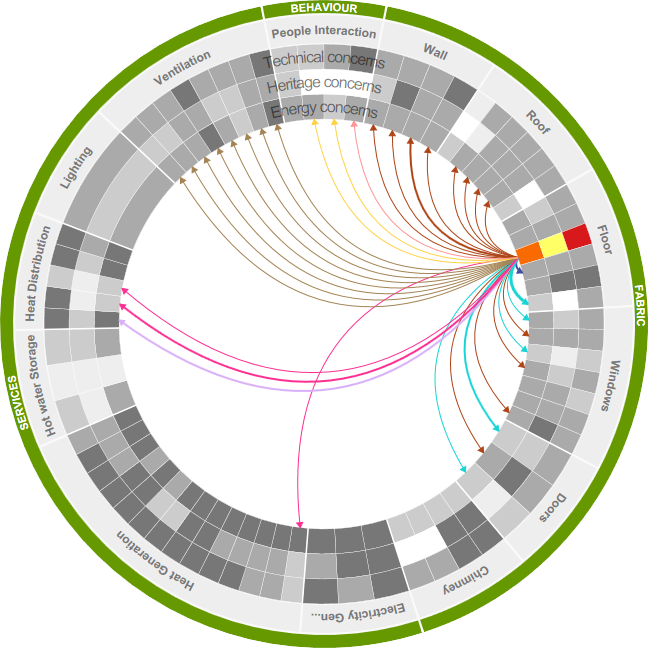What are measures?
A
retrofit measure is a change to an existing building that seeks to improve its performance, in terms
of energy use and its associated CO2 emissions. In doing so the building’s environmental, comfort and aesthetic conditions may be affected. Measures can
affect changes to the building’s structural elements (fabric), changes to the building’s engineering systems providing heating, lighting and power, water, air supply and extract, or its energy supply (services) or changes to the way in which people interact with the building (behaviour).
Fabric
Building fabric, in the context of the Guidance Wheel, refers to the structural elements of the building, its walls, floors, roof and ceilings, windows and doors, and chimneys. These elements separate the inside of the building from the exterior environment, effectively forming a “thermal” envelope.
Retrofit measures to fabric seek to improve the insulation performance of element and restrict uncontrolled air movement. They can either modify the element (for instance window draught proofing or making window shutters operational) or introduce new insulating materials within the building element.
For each building element, there may various ways of achieving improvements of performance, depending on the building specific context, that can be explored. For instance, floors may be solid or suspended and floor insulation could be added above, within or below the existing floor structure.
Services
Building services refer to the plant and equipment within buildings that provide heating, hot and cold water, electricity for lighting and power, and ventilation, which are known as “fixed” services. The supply of energy for heating or electricity from renewable sources of energy is also covered under this section.
Retrofit measures for building services seek to improve the energy efficiency of the system providing heat and power and therefore reduce energy use, as well as decarbonising the supply by providing energy from renewable sources.
Changes may include the replacement of the existing boiler or introduce complete system changes – for example moving to a heat pump or biomass boiler. The provision of good controls for heating, hot water and lighting, and improvements to distribution systems such as the insulation of hot water pipes and cylinders, can also help to reduce energy use.
The provision of adequate air supply and extract for ventilation and retention of human health and good fabric condition is of key importance and can be affected by the need to reduce energy use, as many fabric interventions will reduce uncontrolled air leakage. A correct ventilation strategy needs to be considered as part of any retrofit intervention; possible options include natural or mechanical ventilation with various options for heat recovery and demand control.
Behaviour
Behaviour in the context of the Guidance Wheel refers to the way people use buildings and the variation between the needs of different building users and their impact on energy use.
Measures under this category seek to improve the users’ knowledge of energy efficiency, allowing them to interact and maintain with ease the improvement measures installed in their homes and motivating them to do more.
It is essential to ensure that all occupants understand how to use and control the energy-consuming systems in their properties (i.e. the interface) and they receive clear information about how to do so and how to check and control where energy is being used, so that they can provide feedback and monitor the measures installed in their buildings.

